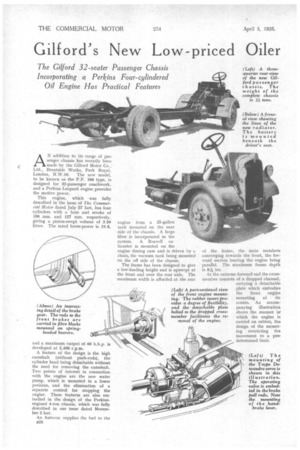Gilford's New Low-priced Oiler
Page 44

Page 45

If you've noticed an error in this article please click here to report it so we can fix it.
AN addition to its range of passenger chassis has recently been made by the Gilford Motor Co., o: Ltd., Brentside Works, Park Royal,
London, N.W.10. The new model, to be known as the P.P. 166 type, is designed for 32-passenger coachwork, and a Perkins Leopard engine provides the motive power.
This engine, which was fully described in the issue of The Commercial Motor dated July 27 last, has four cylinders with a bore and stroke of 100 mm. and 127 mm. respectively. giving a piston-swept volume of 3.99 litres. The rated horse-power is 24.8,
and a maximum Output of 60 b.h.p. is developed at 2,400 r.p.m.
A feature of the design is the high camshaft (without push-rods), the cylinder head being detachable without the need for removing the camshaft. Two points of interest in connection with the engine are the new water pump, which is mounted in a lower position, and the elimination of a separate control for stopping the engine. These features are also embodied in the design of the Perkinsenginecl 4-ton chassis, which was fully described in our issue dated November 2 last, An Autovac supplies the fuel to the s26 engine from a 25-gallon tank mounted on the near side of the chassis. A large filter is incorporated in the system. A Reavell exhauster is mounted on the engine timing case and is driven by chain, the vacuum tank being mounted on the off side of the chassis.
The frame has been designed to give a low-loading height and is upswept at the front and over the rear axle. The maximum width is afforded at the rear
of the frame, the main members converging towards the front, the forward section bearing the engine being parallel. The maximum frame depth is 8-?, ins.
At the extreme forward end the crossmember consists of a dropped channel, carrying a detachable plate which embodies the front engine mounting at its centre. An accompanying illustration shows the manner hr which the engine is carried on rubber, the design of the mounting restricting the movement to a predetermined limit. At the rear the engine is mounted on a banjo cross-member, suitable brackets being provided for the cup-shaped feet on the engine; fibre packing pieces are provided.
In order to provide more room in the cab, the engine is set in the frame at a slight angle. The gearbox is inclined to an angle of 10 degrees from the vertical and thus allows the gear and brake levers, which are bent forwards, lo come to hand, there being no need for additional selector or brake rods.
'I he drive is taken through a singleplate clutch of nearly 12 ins, diameter to the four-speed-and-reverse gearbox, thence by a two-piece open propeller shaft to the fully floating underslung worm rear axle. The standard axle ratio is 5.75 to 1, an alternative ratio of 6.5 to 1 being available if required.
An insulated joint is provided at the forward end of the propeller shaft and is effective in damping out incipient vibration. The spherical centre bearing is carried on a massive tubular cross-member, and allows the shaft to find its own endways location. The rear shaft is equipped with two universal joints of the needle-roller type.
Both the pedal and hand lever operate single-shoe brakes on all four Wheels through the medium of a common cross-shaft, the longer portion of which is of enlarged diameter to resist torsion. Assistance for the foot brake is provided by a T-type Dewandre servo, mounted at the front on the banjo cross-member and at the rear on a bracket attached to the frame.
The vacuum valve is incorporated in the pedal rod, whilst there is a separate rod from the cylinder-operating lever to the cross-shaft. At the point at which the frame is upswept at the rear a channel member carries the hook-up levers for the rear-brake operating rods.
It has been found unnecessary to fit shock absorbers, the long semi-elliptic springs at the front and rear providing good suspension with a marked freedom from bouncing. Steering is effected through a cam and lever gear, the track rod being mounted behind the front axle to provide a good steering lock The battery, which has a capacity of 150 ampere-hours, is mounted in a cradle on the chassis frame beneath the driver's seat, and the dynamo has an output of 300 watts.
Goodyear low-pressure -tyres are fitted all round, and a spare wheel and tyre • is accommodated in a hinged carrier beneath the frame at the rear.
The wheelbase is 16 ft. 6 ins., and the body space available is 20 ft. 114 ins. . The chassis weight has by careful design been kept low and is but 24 tons. The gross laden weight should be under 64 tons.
The equipment includes a C.A.V.Bosch electric starter with sliding armature and a five-lamp lighting set with a headlight dipping device. The chassis price is £695. Judging by the careful design and workmanship, this machine represents excellent value.




































































































